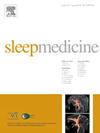Sleep problems in youth with WAGR syndrome
IF 3.8
2区 医学
Q1 CLINICAL NEUROLOGY
引用次数: 0
Abstract
Objectives
Children with WAGR syndrome, an ultra-rare genetic condition associated with deletion of the brain-derived neurotrophic factor (BDNF), may be at increased risk for sleep problems, but there are limited data assessing sleep in this population. This study aimed to compare sleep disturbances and sleep-disordered breathing in youth with WAGR syndrome compared to healthy youth.
Methods
Parents of youth with WAGR syndrome and healthy controls completed an online survey including demographics, the PROMIS Pediatric Sleep Disturbance item bank, and the Pediatric Sleep Questionnaire Sleep-Related Breathing Disorders scale (PSQ-SRBD).
Results
Fifteen youth with WAGR syndrome, median (interquartile range) age 10 (7,11) years and 27 controls 9 (6, 10) years were included. PROMIS Sleep Disturbance T-scores were higher in youth with WAGR syndrome (58.1 [53.3, 66.1]) versus controls (52.5 [44.3, 58.3], p = 0.03) indicating more sleep disturbance. Melatonin was used for sleep in 7 (47 %) youth with WAGR syndrome versus 3 (11 %) controls (p = 0.009). PSQ-SRBD scores were greater in youth with WAGR syndrome (0.52 [0.45, 0.65]) compared to controls (0.09 [0.05, 0.18], p < 0.001); 93 % of youth with WAGR syndrome had elevated PSQ-SRBD scores. One-third of youth with WAGR syndrome reported having a diagnosis of obstructive sleep apnea. No differences in sleep outcomes were identified based on BDNF deletion status in those with WAGR syndrome.
Conclusions
Sleep disturbances and sleep-disordered breathing are prevalent in youth with WAGR syndrome. Diverse cohorts with clinical data including polysomnography are needed to confirm these findings.
求助全文
约1分钟内获得全文
求助全文
来源期刊

Sleep medicine
医学-临床神经学
CiteScore
8.40
自引率
6.20%
发文量
1060
审稿时长
49 days
期刊介绍:
Sleep Medicine aims to be a journal no one involved in clinical sleep medicine can do without.
A journal primarily focussing on the human aspects of sleep, integrating the various disciplines that are involved in sleep medicine: neurology, clinical neurophysiology, internal medicine (particularly pulmonology and cardiology), psychology, psychiatry, sleep technology, pediatrics, neurosurgery, otorhinolaryngology, and dentistry.
The journal publishes the following types of articles: Reviews (also intended as a way to bridge the gap between basic sleep research and clinical relevance); Original Research Articles; Full-length articles; Brief communications; Controversies; Case reports; Letters to the Editor; Journal search and commentaries; Book reviews; Meeting announcements; Listing of relevant organisations plus web sites.
 求助内容:
求助内容: 应助结果提醒方式:
应助结果提醒方式:


